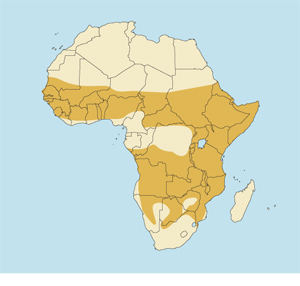 |
Crocuta crocuta
Hiena con manchas (Sp), Fleckenhyäne (G), Hyène tachetée (F), Gevlekte hiëna (Af).
DESCRIPTION Length, including tail, 4 to 6-1/2 feet (120-200 cm). Shoulder height 28-35 inches (70-90 cm). Weight 100-175 pounds (45-80 kg). Females are about 10 percent larger and heavier than males.
The largest member of the hyena family, very powerfully built, with a massive head, rounded ears and a very sloping back. The jaws are exceptionally powerful in proportion to body size. The coat is normally quite short, although it grows longer in colder mountain regions. It varies in color from dirty yellow to dull gray, and is covered with dark brown, rounded spots. There is no mane or only a slight one. The tail has a brushy black tip. The external genitalia of the female so closely resemble those of the male that it is difficult to determine the sexes. The clitoris looks like a penis, is located in the same position, and is capable of elongation and erection. In addition, the female has two sacs filled with fibrous tissue that look very much like a scrotum and are located in the same place. This resemblance has caused the popular misconception that the animal is hermaphroditic.
Besides its genitalia, the spotted hyena differs from the other species of hyenas in its larger size, spotted coat, rounded ears, maneless back and much smaller upper molars.
BEHAVIOR Lives in groups or clans with marked and defended territories, but may hunt alone or in smaller packs. Females are dominant over males. Breeding takes place throughout the year, with a possible peak in the rainy season. After a 3-1/2 month gestation period, usually two cubs (range is 1-3) are born in holes in the ground. Each clan has a central denning site where all females bear their young. Males are sexually mature at two years, females at three. A captive specimen lived for 41 years.
Carnivorous, with most activity at night or twilight. Commonly thought of as a scavenger and carrion-eater; however, it actually kills far more animals than it consumes as carrion. Its diet is mainly medium-sized to large animals such as wildebeests and zebras-mostly very young, very old, or otherwise weak animals. Roughly one-third of its hunting attempts are successful. In the absence of game it will turn to domestic livestock, or even humans. People sleeping in the open, or in open tents, have been killed or mutilated by having their faces or other parts bitten off. Will eat anything, including vegetable matter and animal droppings; all parts of a carcass are eaten, including bones, hoofs, hair and skin. Drinks water regularly. Sense of smell is extremely good; eyesight and hearing are very good. A very noisy animal, with growls, high-pitched screams and its unforgettable "laugh." Its reputation for being cowardly is unfounded, for it defends itself and its young bravely and fiercely. Only a moderately fast runner, but untiring.
HABITAT All types of open habitat at elevations up to 13,000 feet (4,000 m).
DISTRIBUTION Nearly everywhere in Africa south of the Sahara, except in the equatorial rain forest. Probably the most numerous of the larger African predators.
During the Pleistocene Epoch, the spotted hyena also occurred in much of Europe and Asia.
REMARKS Long considered more vermin than game animal. Not actively pursued by many sportsmen, but taken as a target of opportunity. Most readily taken at night by moonlight or spotlight (where lawful), especially over a carcass or garbage pile. Will come to a call. The skin is an interesting trophy and the skull and teeth are awesome. Can be dangerous when wounded.
TAXONOMIC NOTES<'strong> A number of subspecies were named at one time, but are no longer considered valid.
|





